
Mark Rothko, born Markus Yakovlevich Rothkowitz, was a Latvian-born American abstract painter. He is best known for his color field paintings that depicted irregular and painterly rectangular regions of color, which he produced from 1949 to 1970. Although Rothko did not personally subscribe to any one school, he is associated with the American abstract expressionism movement of modern art.
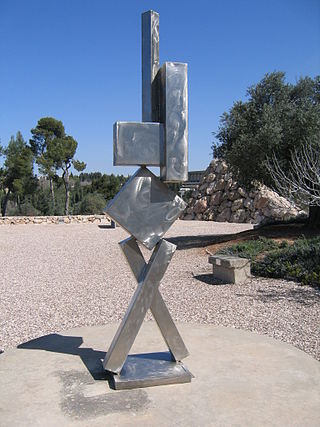
Abstract expressionism in the United States emerged as a distinct art movement in the immediate aftermath of World War II and gained mainstream acceptance in the 1950s, a shift from the American social realism of the 1930s influenced by the Great Depression and Mexican muralists. The term was first applied to American art in 1946 by the art critic Robert Coates. Key figures in the New York School, which was the epicenter of this movement, included such artists as Arshile Gorky, Jackson Pollock, Franz Kline, Mark Rothko, Norman Lewis, Willem de Kooning, Adolph Gottlieb, Clyfford Still, Robert Motherwell and Theodoros Stamos among others.

Clyfford Still was an American painter, and one of the leading figures in the first generation of Abstract Expressionists, who developed a new, powerful approach to painting in the years immediately following World War II. Still has been credited with laying the groundwork for the movement, as his shift from representational to abstract painting occurred between 1938 and 1942, earlier than his colleagues like Jackson Pollock and Mark Rothko, who continued to paint in figurative-surrealist styles well into the 1940s.

Las Meninas is a 1656 painting in the Museo del Prado in Madrid, by Diego Velázquez, the leading artist of the Spanish Baroque. It has become one of the most widely analyzed works in Western painting for the way its complex and enigmatic composition raises questions about reality and illusion, and for the uncertain relationship it creates between the viewer and the figures depicted.

The Rothko Chapel is a non-denominational chapel in Houston, Texas, founded by John and Dominique de Menil. The interior serves not only as a chapel, but also as a major work of modern art: on its walls are fourteen paintings by Mark Rothko in varying hues of black. The shape of the building—an octagon inscribed in a Greek cross—and the design of the chapel were largely influenced by the artist. The chapel sits two miles southwest of downtown in the Montrose neighborhood, situated between the building housing the Menil Collection and the Chapel of Saint Basil on the campus of the University of Saint Thomas. About 110,000 people visit the chapel each year.

Lenore "Lee" Krasner was an American Abstract Expressionist painter and visual artist active primarily in New York. She received her early academic training at the Women's Art School of Cooper Union, and the National Academy of Design from 1928 to 1932. Krasner's exposure to Post-Impressionism at the newly opened Museum of Modern Art in 1929 led to a sustained interest in modern art. In 1937, she enrolled in classes taught by Hans Hofmann, which led her to integrate influences of Cubism into her paintings. During the Great Depression, Krasner joined the Works Progress Administration's Federal Art Project, transitioning to war propaganda artworks during the War Services era.

Franz Kline was an American painter. He is associated with the Abstract Expressionist movement of the 1940s and 1950s. Kline, along with other action painters like Jackson Pollock, Willem de Kooning, Robert Motherwell, John Ferren, and Lee Krasner, as well as local poets, dancers, and musicians came to be known as the informal group, the New York School. Although he explored the same innovations to painting as the other artists in this group, Kline's work is distinct in itself and has been revered since the 1950s.

Al Held was an American Abstract expressionist painter. He was particularly well known for his large scale Hard-edge paintings. As an artist, multiple stylistic changes occurred throughout his career, however, none of these occurred at the same time as any popular emerging style or acted against a particular art form. In the 1950s his style reflected the abstract expressionist tone and then transitioned to a geometric style in the 1960s. During the 1980s, there was a shift into painting that emphasized bright geometric space that's deepness reflected infinity. From 1963 to 1980 he was a professor of art at Yale University.
Events from the year 1958 in art.
The Art of This Century gallery was opened by Peggy Guggenheim at 30 West 57th Street in Manhattan, New York City on October 20, 1942. The gallery occupied two commercial spaces on the seventh floor of a building that was part of the midtown arts district including the Museum of Modern Art, the Museum of Non-Objective Painting, Helena Rubinstein's New Art Center, and numerous commercial galleries. The gallery exhibited important modern art until it closed in 1947, when Guggenheim returned to Europe. The gallery was designed by architect, artist, and visionary Frederick Kiesler.

Theodoros Stamos was a Greek-American painter. He is one of the youngest painters of the original group of abstract expressionist painters, which included Jackson Pollock, Willem de Kooning and Mark Rothko. His later years were negatively affected by his involvement with the Rothko case.

The Four Seasons Restaurant was a New American cuisine restaurant in the Midtown Manhattan neighborhood of New York City from 1959 to 2019. The Four Seasons operated within the Seagram Building at 99 East 52nd Street for most of its existence, although it relocated to 42 East 49th Street in its final year of operation. The restaurant was themed around the seasons of the year, with menus, decorations, and vegetation that changed every three months. It attracted numerous high-profile personalities and often hosted "power lunches". Despite mixed commentary of the restaurant's food, the Four Seasons was highly popular, winning the James Beard Award many times.
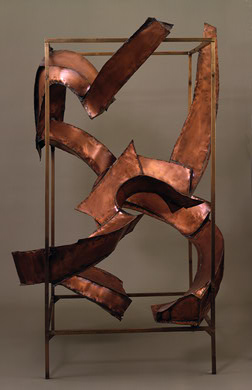
Herbert Ferber was an American Abstract Expressionist, sculptor and painter, and a "driving force of the New York School."
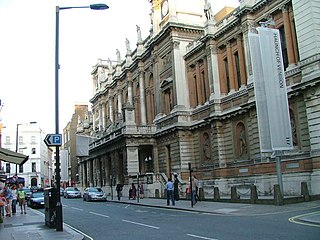
Haunch of Venison was a contemporary art gallery operating from 2002 until 2013. It supported the work of contemporary leading artists, presented a broad and critically acclaimed program of exhibitions to a large public through international exhibition spaces in London and New York.
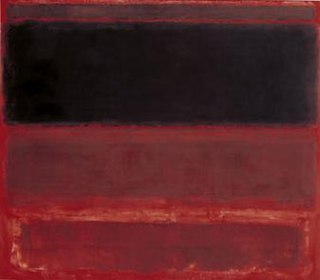
Four Darks in Red is a 1958 painting by American painter Mark Rothko. It is currently in the collection of the Whitney Museum of American Art in New York City.
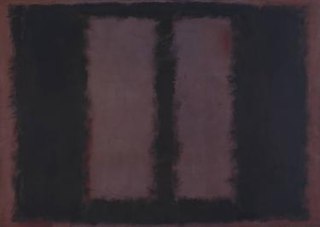
Black on Maroon is a mixed media painting by Mark Rothko, created in 1958. It is housed at the Tate Modern, in London.
Mala Breuer was an American Abstract Expressionist. Her work is in the collections of the San Francisco Museum of Modern Art, Albright Knox Art Gallery in Buffalo, and the Museum of Fine Arts, Santa Fe, New Mexico.

Crossroads is a 2013 mural that consists of two acrylic on canvas paintings by the artist Ismael Muhammud Nieves. It is located within the Eskenazi Outpatient Care Center on the Sidney and Lois Eskenazi Hospital campus, near downtown Indianapolis, Indiana, USA, and is part of the Eskenazi Health Art Collection.
The Ten, also known as The Ten Whitney Dissenters, were a group of New York–based artists active from 1935 to 1940. Expressionist in tendency, the group was founded to gain exposure for its members during the economic difficulty of the Great Depression, and also in response to the popularity of Regionalism which dominated the gallery space its members sought.

Rubén Sánchez also known as Zoonchez is a Spanish artist known for creating colorful compositions in his works, mostly with elements in balance. He has made sculptures and large-scale public murals works in Canada, UAE, France, Jordan, Germany, Turkey, Hungary, Sweden and the United States.



















